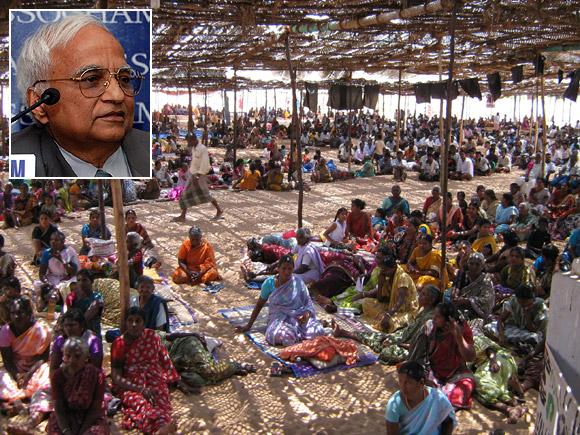
Ten years ago, recalls nuclear scientist Dr G R Srinivasan, the people of Kudankalam had accepted the nuclear plant and those associated with it.
"Kudankulam has got a special design to tackle tsunamis and earthquakes. I can assure people that earthquakes or tsunamis will not affect the plant. It may have to be shut down for a day or two. Once everything is back to normal, the plant can be restarted."
Dr G R Srinivasan, former vice-chairman, Atomic Energy Regulatory Board of India, is one of India's most respected nuclear scientists.
In this exclusive interview with Rediff.com's Shobha Warrier, Dr Srinivasan -- who has more than 50 years of experience in the nuclear industry -- discusses the Kudankulam nuclear power plant, against which a renewed agitation commences on Tuesday, May 1.
After the Fukushima nuclear power accident and the tsunami threat earlier this month, people all over the world and those in Tamil Nadu are extremely scared of nuclear power plants. Would you say their fears are unfounded?
I would not say their fears are unfounded. They are legitimate fears and they have to be addressed. Unfortunately, deliberate misinformation is given at times. Hence, people may be afraid.
At the same time, it is very difficult to make people understand a complex subject like nuclear energy. They may ask questions, but they are not able to follow the answers which we give them.
A professional is needed to explain the complex subject properly. I would say we need the media to explain (the subject) to them.
Please ...
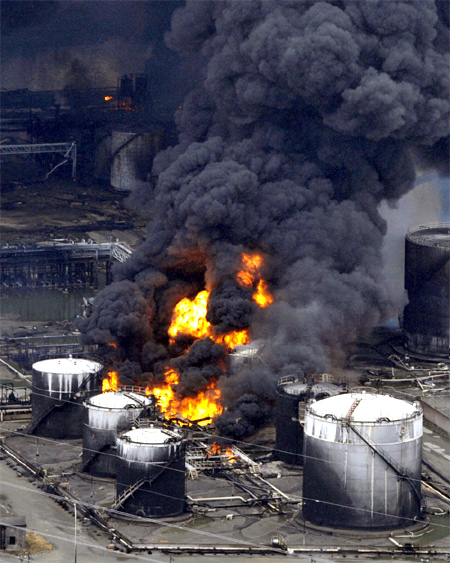
What would you tell the people of Kudankulam who are scared of a tsunami striking there and the plant getting affected?
First of all, India is not in a subduction zone. We also will not get a nine metre high tsunami.
California, Japan, Indonesia, etc, are places where the intensity level of an earthquake can be eight and above on the Richter Scale. In India, we never have had such heavy earthquakes.
The Kudankulam plant, as well as the Jaitapur plant, will easily withstand earthquakes of the intensity that occurred in India's Western region on April 14, as well as the aftershocks of the earthquake that struck Indonesia on April 11.
In fact, the nuclear plants at Kalpakkam, Tarapur, Kaiga and Kakrapar continued to operate safely during these earthquakes.
Kalpakkam has already seen a tsunami and there was no problem.
Kudankulam has got a special design to tackle tsunamis and earthquakes. I can assure people that earthquakes or tsunamis will not affect the plant.
It may have to be shut down for a day or two. Once everything is back to normal, the plant can be restarted.
I also want to point out that Kudankulam is very different from the Fukushima plant. I can list 15 different features which will tackle each and every thing that occurred in Fukushima.
It is an over-reaction to ask the Kudankulam plant to shut down just because the Fukushima plant was affected.
Are you saying the Kudankulam plant is safer and has used modern technology?
The technology used at Kudankulam is very advanced. Twenty years ago, after Chernobyl took place (on April 26, 1986), many scientists started working on designs for nuclear power plants that ensured almost no action is required on the public domain even in accidents as severe as Chernobyl and Fukushima.
Beyond 500 metres, nothing will be affected even when the plant has some damage.
Due to these advanced features, there won't be any problem to the public and the environment.
The Kudankulam plant has all these safety features.
Please ...

Do you think people in general are against nuclear energy?
In fact, a majority of people all over the world are nuclear friendly.
In India, we have been using nuclear energy for the last 50 years. There are people who are living around our nuclear power plants for many decades.
For example, we started the plant in Rajasthan in 1970. Forty-two years have passed and not a single person has moved away. In fact, the population has continuously increased and they are very happy there.
India is among the top 10 nuclear power producers in the world; we have 20 nuclear power plants. This would not have been possible without public support.
If people have doubts, they has to be cleared.
A small percentage of the people may be anti-nuclear and they may not change their opinion. It is possible to wake up a sleeping person, but not a person who is pretending to sleep.
Public acceptance and policy-makers's reactions after the Fukushima accident has been much more mature than what we saw after Chernobyl and Three Mile Island.
At that time, they would say shut down all nuclear power plants. Now, they ask, how many more we should build, what modifications we should make, how can they be made more safe, etc.
They are much more mature because one generation has grown up with nuclear power. But we may need one more generation (to do so) before it becomes part of our everyday life.
Take a train journey for example. More than 200, 300 people may die in an accident, but people will board the same train the next day. Nobody is afraid that they may also get killed in another accident. That is because travelling by train has become a part of our everyday life.
Similarly, it will take another generation for nuclear power to become part of everyday life.
In Tamil Nadu, there is already a nuclear power plant at Kalpakkam. Why do you think there is so much protest and resistance to Kudankulam? Has it anything to do with what happened at Fukushima?
In my opinion, it has nothing to do with Fukushima.
Fukushima happened in March and the resistance started in October. I don't think it takes 6, 8 months for someone to realise there is a risk.
When the plant started 10 years ago at Kudankulam, people living in that area had a wonderful relationship with those working in the plant.
Many of our friends used to say that people in that area used to see them off warmly. They had accepted the plant and those associated with it.
You can imagine why there is so much hostility now. I don't want to say anything more.
Please ...
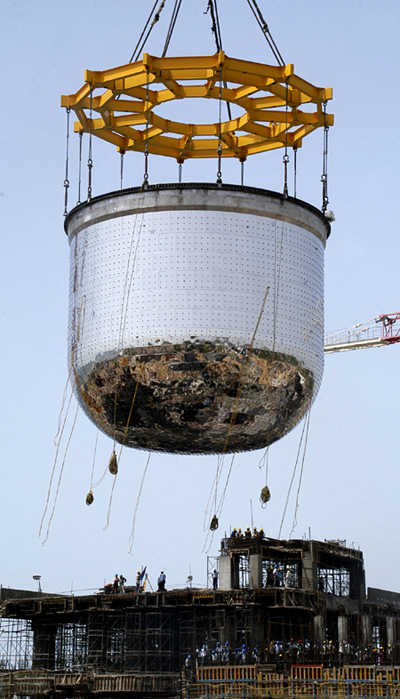
How safe would you say is the Kudankulam plant?
Look at what happened at Fukushima.
First there was an earthquake. Then there was a tsunami. Then there was a mains power failure. Consequently, the emergency diesel generators failed and there was no power.
The cooling failed both in the fuel storage and the reactor. There was a chemical reaction between water and the cladding material zirconium alloy (at high temperatures, zirconium is oxidised by water and steam and hydrogen is released).
Under normal circumstances, the hydrogen would be recombined with oxygen in a regulated way to form water. As there was no power, the recombiner failed and the hydrogen eventually exploded.
In all the power plants India is importing, including Kudankulam, there are passive autocatalytic recombiners. Since no power is required to recombine hydrogen and oxygen, no chemical explosion will take place.
The recombiner at Fukushima needed power.
We have diesel generators which are designed to cope with a station blackout when the external power and all the four regular diesel generators fail.
For nearly three to four days, no action is required; the reactor will be cooled without any effort from the operator.
Despite this, if there is a problem, the core will be caught by a core catcher.
There are four diesels generators, four pumps as well as multiple passive cooling systems. As a result, cooling will take place without any power requirement by natural processes such as convection, gravity, etc.
To imagine that all of them will fail at the same time is far-fetched.
There is double containment in most of the places and there's a steel liner no radioactivity will escape.
I would say they have gone out of the way to address all severe accidents scenarios. Even in a case worse than Fukushima, minimum action is required in the public domain.
I must give you some statistics to clear the fears of people.
Out of the fatal accidents that have taken place in the world until now, 1,656 accidents have taken place in thermal power plants in which 47,000 people died.
In hydro power plants, 11 fatal accidents have taken place in which 30,000 people died.
In nuclear power plants, one fatal accident took place at Chernobyl in which 31 people died instantly.
Please ...

Another fear that the people living near the Kudankulam plant have is regarding nuclear waste.
What happens to it and will it have any harmful effect on the people of that area?
Nuclear waste is a problem, but a solution is technologically possible.
India follows a closed cycle. Here, we should not use the word spent fuel; we should say partially used fuel.
Countries which do not follow a closed cycle also have unused fuel.
In a closed process, plutonium, uranium, etc, are recovered, so the volume of radioactive waste is reduced.
For example, if you generate enough power for 25 years for a family, the active waste after reprocessing will be equal to a handful only. But it will be very radioactive.
We already have the process by which we can fix the waste through a glass matrix or ceramic matrix which will not allow the waste to leak out for thousands of years.
We can bury it in unused mines.
People need not worry and can have confidence that the problem of nuclear waste will be solved technologically.
People living around Kudankulam also fear radiation.
Nuclear energy is one of the safest forms of energy. In the last 14,000 odd reactor years, only 31 people have died due to accidents, which is sad.
If you look at India's reactors, in which 340 reactor years have been completed by the 20 reactors, the safety performance has been good.
An independent environmental survey is continuously conducted around all the 20 reactors; this study has been accredited by the ministry of environment and forests.
They have taken 3,000 samples of fish, milk, soil, grass, etc, to find out how much radiation a person will be exposed to if s/he is near the plant 24 hours a day, 365 days in a year.
The survey found that staying near a nuclear reactor did not cause any health hazard. Radiation in the public domain was to 2 to 3 units per year to the already existing natural background of 200 units. That means the radiation increases from 200 to 202 or 203.
This 2 to 3 units can be compared to the 100 units that are safely permitted by regulatory bodies all over the world, including the Atomic Energy Regulatory Board.
Please ...
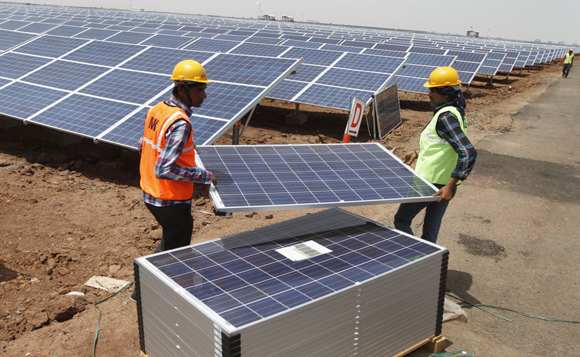
Is nuclear energy anti-environment?
Nuclear energy is called green energy because it does not emit any greenhouse gases. It is one of the safest sources of energy.
Nuclear energy is part of sustainable development. It conserves fuel. As a result, there is enough fuel available for several generations. There is continued effort to develop it as a clean development mechanism.
Why is it that the Green parties are anti-nuclear energy, like for instance, in Germany?
There are some people who are always against nuclear energy. It is a complicated landscape. Several Green activists with whom I have interacted recently are adopting to a pro-nuclear stance.
There is also a talk of world moving towards renewable energy. Is it possible to move on to a system of renewable energy using solar energy, bio-mass, wind, etc?
Renewable energy is not a bulk source of energy. For example, I understand the total capacity of solar energy for the whole world is 500 MW. It may go up slowly.
Wind energy constitutes only 10 to 15 MW.
Renewable sources of energy must be encouraged and developed, but they cannot substitute as a bulk source, which is thermal, nuclear and hydro to some extent.
For example, 1 unit at Jaitapur will generate 1,700 MW. India needs 800,000 MW by 2030 to even have a modest per capita consumption of 5,000 KW per head.
In a small county like Luxembourg, which has a small population, you can have renewable energy. But the whole world cannot survive on renewable energy alone.
Please ...
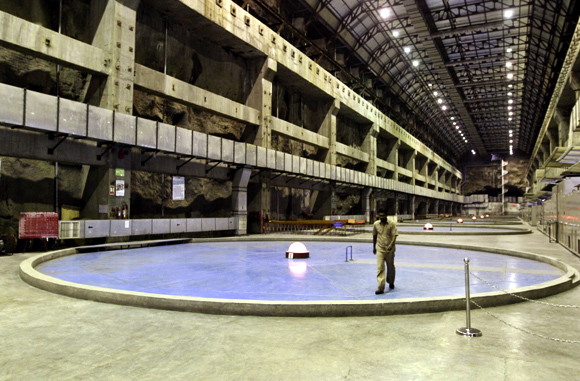
Is nuclear energy the only option for India to meet its energy needs?
Let's suppose India needs 800,000 MW of energy. It is not possible to generate that much energy with coal as coal will run out in 11 years. We are importing coal even now.
We will not have energy security and energy independence if we rely on coal alone.
Uranium and thorium can be managed for 200 years. The thorium we have is enough for 358 GW, which will last us 1,000 years. By 2040, you will have an energy gap of 70,000 to 80,000 MW which can only be filled by nuclear energy.
We have to encourage nuclear energy as we have a large amount of thorium.
India needs to have four pillars to generate energy -- thermal, renewable, nuclear and improving energy efficiency.
All these four should be independently encouraged because India needs so much energy.
It's not just India -- all developing countries and emerging economies are going for nuclear energy. Of the 11 countries that have more than 10 reactors, the UK, US and Canada have announced that they will go for more nuclear power plants aggressively.
Germany will likely to phase out. Japan is yet to decide.
The remaining six countries -- France, China, India, Russia, South Korea and Ukraine -- have live nuclear programmes. More than 94 countries have announced that they will opt for nuclear energy.
Even the UAE, which has a lot of oil, is building nuclear power plants.
After Fukushima, the nuclear industry will change. But the need for nuclear energy will not change.